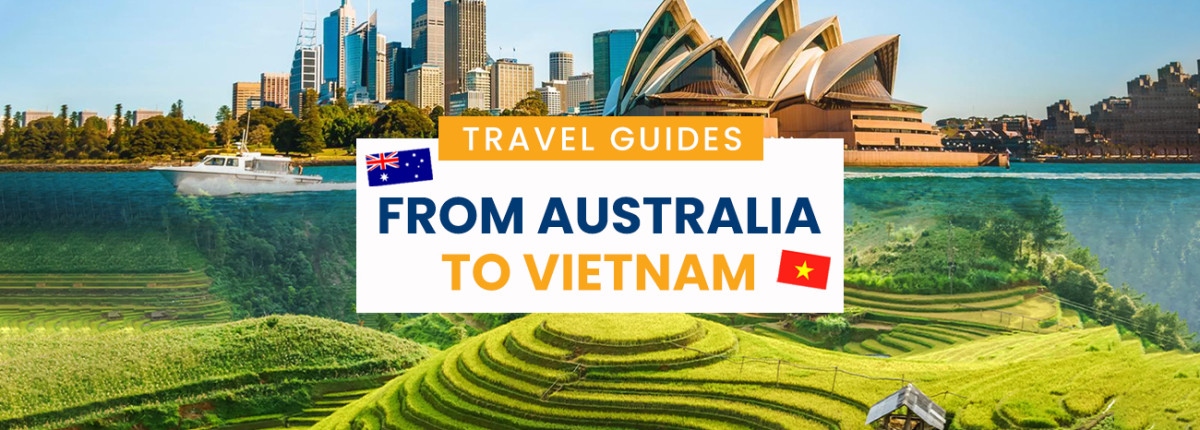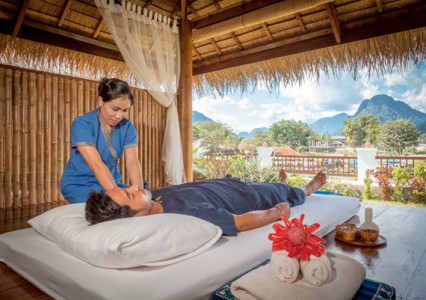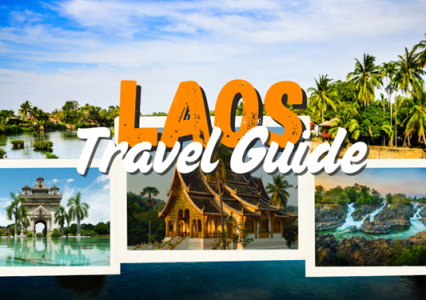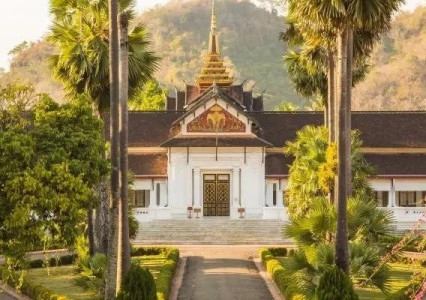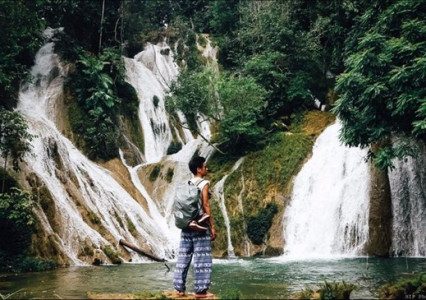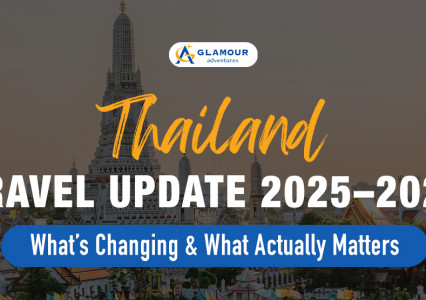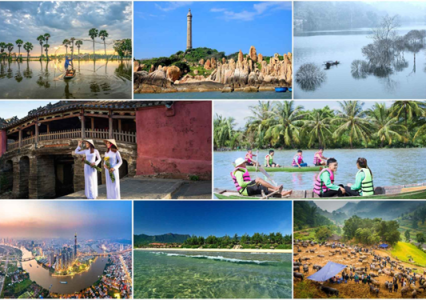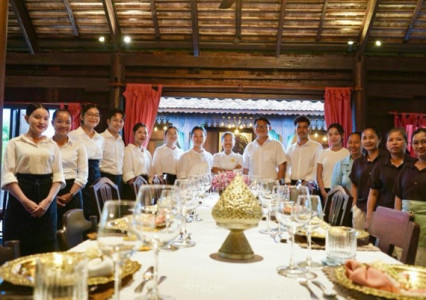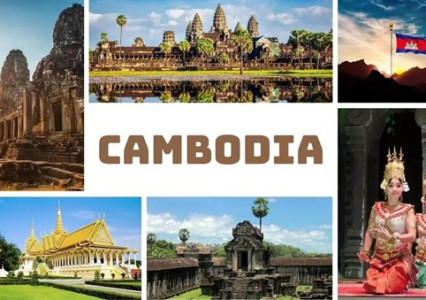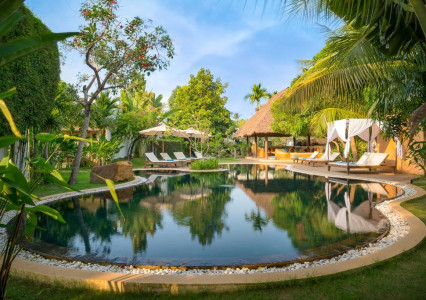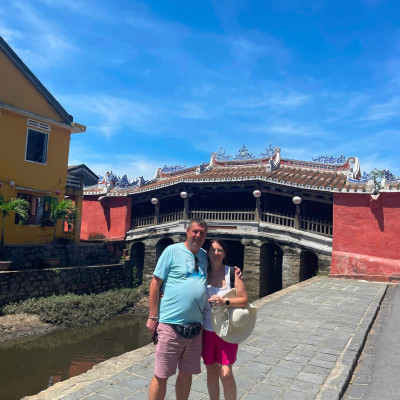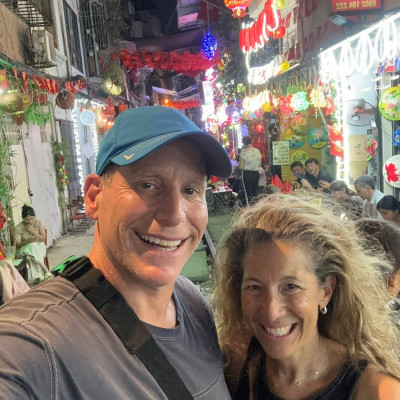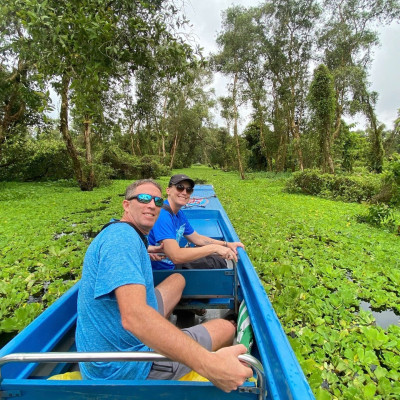Your Ultimate Travel Guide: Holidaying in Vietnam from Australia
Vietnam Visa Requirements for Australian Citizens
If you're an Australian citizen planning a trip to Vietnam, you have two main visa options: applying online for an e-visa or visiting the Vietnamese Embassy in Australia.
The most convenient option is the Vietnam e-visa, which allows multiple entries and a maximum stay of up to 90 days. To apply, follow these steps:
- Visit the official website of the Vietnam Immigration Department.
- Complete the online application form, including uploading a passport-sized photo and a scanned copy of your passport’s data page.
- Pay the e-visa fee online using a credit or debit card.
- Receive your e-visa approval letter via email (typically within 3 business days).
- Print the approval letter and present it upon arrival in Vietnam.

Important Tips:
- Your passport must be valid for at least 6 months from your arrival date.
- Make sure your passport has at least one blank page for the visa stamp
There are different types of Vietnam visas available for Australian citizens, depending on the way of application, purpose of the visit, and duration of stay in Vietnam. Here are the most popular types of Vietnam visa for Australian citizens at the moment:
- Regarding the way of application: e-visa
- Regarding the purpose of visit: Tourist visa ,Business visa, Relative visit visa,
- Regarding the length of stay in Vietnam: 30 days single entry, 30 days multiple entry, 90 days single entry, 90 days multiple entries
How to Apply for an E-Visa
- Visit the official Vietnam e-visa portal: https://evisa.gov.vn
- Complete the online application form and upload the required documents
- Pay the visa fee online
- Wait for the approval email (usually within 3–5 working days)
- Print the e-visa approval and present it upon arrival in Vietnam
How to Get There: Flying from Australia to Vietnam
Traveling from Australia to Vietnam has never been easier! With a wide range of airlines offering both direct flights and convenient stopovers, booking your journey is simple and stress-free.
Major Australian cities like Sydney, Melbourne, and Brisbane frequently operate flights to Vietnam, with Ho Chi Minh City being one of the most popular arrival points for Aussie travelers. Whether you're planning a quick getaway or a longer adventure, Vietnam is just a flight away!
Direct Flights
The fastest and most convenient way to reach Vietnam is by taking a direct flight from major Australian cities such as Sydney, Melbourne, or Brisbane to Vietnam’s key international airports—Hanoi (Noi Bai) or Ho Chi Minh City (Tan Son Nhat).
- Flight duration: Approximately 8–9 hours.
- Airlines offering direct flights: Vietjet, Qantas, Vietnam Airlines, Jetstar, and Virgin Australia.
Flights with Layovers
If you're looking to save on airfare or don't mind a slightly longer journey, consider flights with layovers in major hubs like Kuala Lumpur, Singapore, or Bangkok.
- Airlines such as AirAsia, Scoot, and Thai Airways offer affordable routes with stopovers.
- While this can increase your total travel time, it often results in lower ticket prices.
Traveling by Cruise
For a more unique and leisurely journey, some cruise lines offer trips from Australia to Vietnam. While this is a less common and longer travel option, it's perfect for travelers seeking adventure and scenic ocean views.
- Cruises may dock at ports like Da Nang, Ho Chi Minh City, or Ha Long Bay.
- Advance planning is essential, as cruise availability and schedules vary.
Reminder:
Don’t forget to arrange your Vietnam visa in advance. Australian citizens are required to obtain a visa, which can be easily done online (via e-visa) or through the Vietnamese Embassy in Canberra.
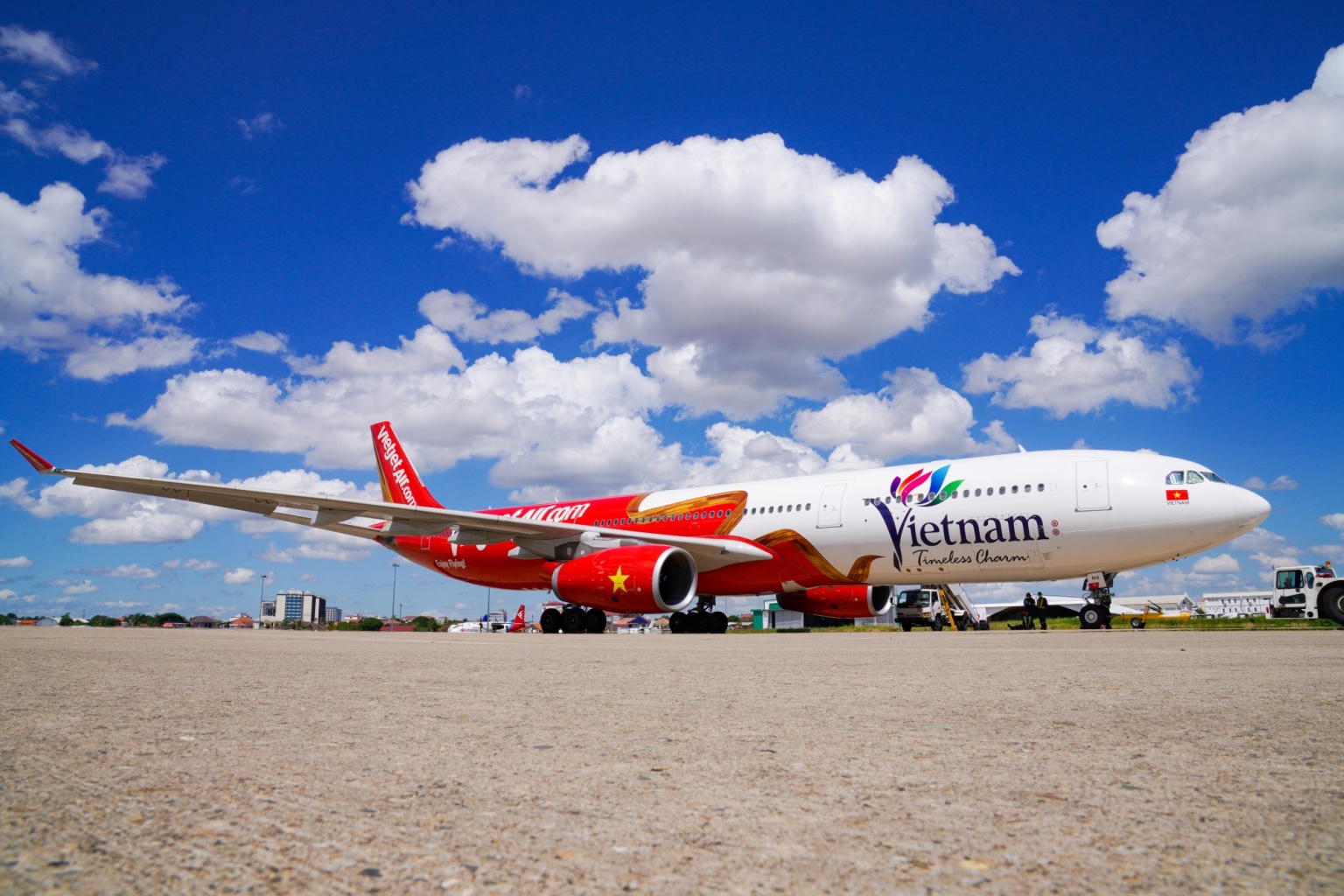
Best time to travel to Vietnam
North Vietnam (Hanoi, Sapa, Halong Bay)
Northern Vietnam has a distinct seasonal climate, with cold, dry winters from December to February, where temperatures can drop as low as 4°C—especially in mountainous areas like Sapa. Summers (May to August) are hot and humid.
✅The best time to visit is during spring (March–April) and autumn (September–November) when the weather is mild, sunny, and ideal for sightseeing and outdoor adventures.
Central Vietnam (Hue, Hoi An, Da Nang)
This region experiences typhoon season from August to November, bringing heavy rains and strong winds, especially along the coast. Rain typically eases by February, giving way to dry, sunny weather.
✅ The ideal travel window is from February to August, with July and August offering hot, sunny days around 30°C—perfect for beach lovers.
South Vietnam (Ho Chi Minh City, Mekong Delta)
With tropical temperatures year-round, southern Vietnam is generally warm and travel-friendly at any time. The dry season runs from December to May, while the rainy season lasts from June to November.
While downpours can happen, they're usually short and refreshing. The monsoon months offer stunning scenery, especially in the Mekong Delta.
✅March to May can be extremely hot, with temperatures soaring to 40°C, so be prepared if traveling during this period.
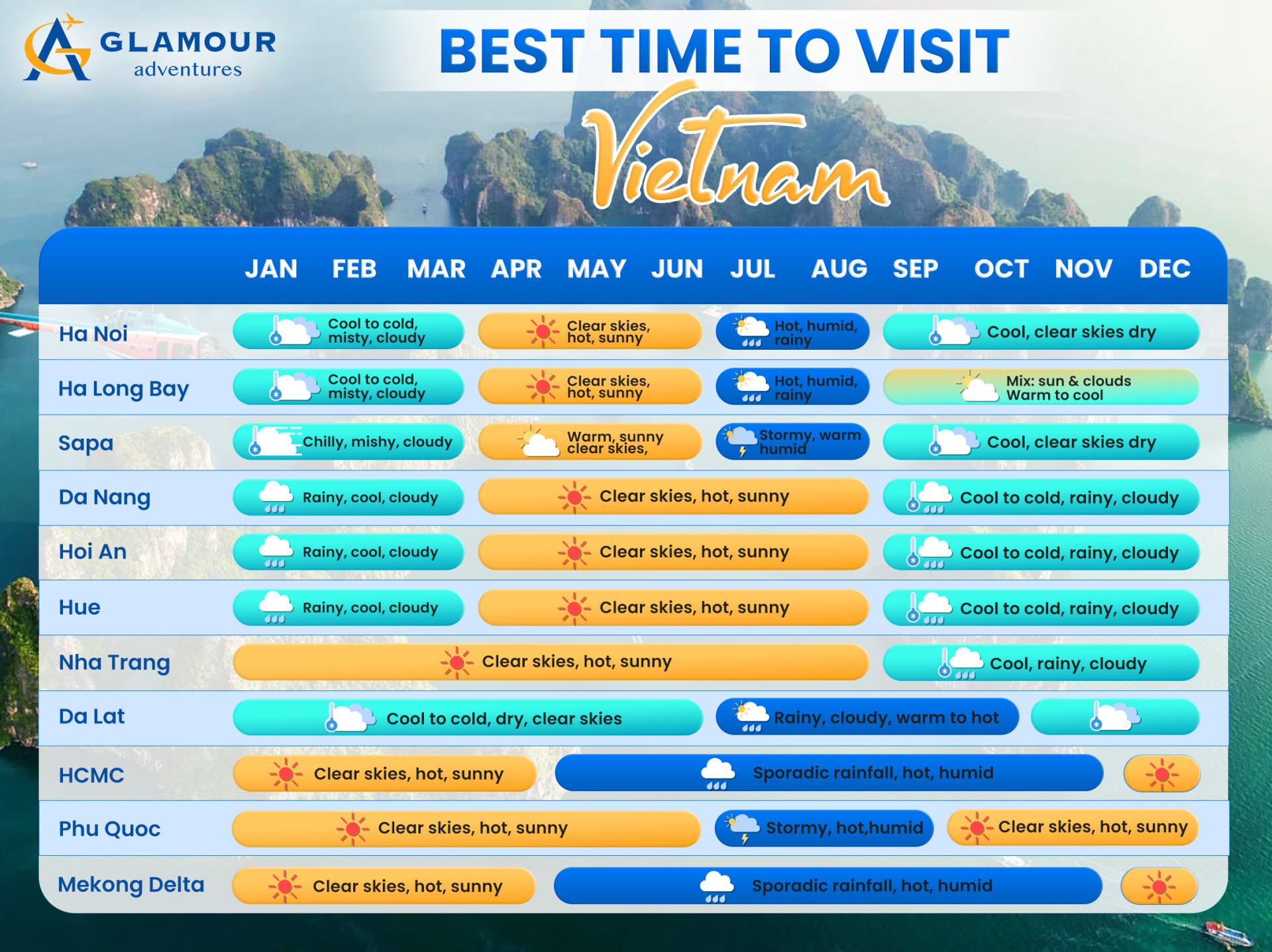
Top Destinations in Vietnam
Hoi An
Hoi An enchants visitors with its beautifully preserved ancient town, characterized by yellow-walled houses, lantern-lit streets, and historic bridges. The city is also a culinary gem, offering unique regional dishes such as Cao Lau noodles. Hoi An’s bustling night market is the perfect place to shop for handmade goods, silk products, and traditional souvenirs.
Da Nang
A balanced mix of beachside relaxation and cultural discovery, Da Nang is an ideal destination for a laid-back holiday. Mornings can be spent enjoying the coastline and ocean views, while afternoons invite exploration of ancient temples and pagodas. In the evening, head to one of Da Nang’s night markets to sample local street food and pick up memorable souvenirs.
Ha Long Bay
Located in northeastern Vietnam, Ha Long Bay is a natural wonder known for its towering limestone formations and emerald waters. It’s a must-visit for those seeking an unforgettable experience. Visitors can explore the bay by traditional wooden junk boats or paddle through smaller coves and hidden lagoons by kayak. The dramatic scenery and peaceful atmosphere make it a highlight of any trip to Vietnam.
Phu Quoc
This idyllic island is known for its lush landscapes and diverse range of activities. Whether you're lounging on the beach, exploring traditional fishing villages, or hiking through national parks, Phu Quoc has something for everyone. Water enthusiasts can enjoy snorkeling, diving, and kayaking, while those seeking relaxation will find peace at the island's many serene spas. Be sure to try the local seafood and visit the lively night markets for an authentic experience.
Hanoi
The capital city of Vietnam, Hanoi is a captivating mix of history and modernity. Visit the Ho Chi Minh Mausoleum, explore the Old Quarter, enjoy traditional water puppetry shows, and try authentic Vietnamese cuisine in this bustling city.
Sapa
Located in the northern highlands, Sapa is renowned for its stunning terraced rice fields and breathtaking mountain views. It's a great destination for trekking, with numerous trails that take you through traditional ethnic minority villages. Whether you're exploring the Fan Si Pan mountain—the highest peak in Vietnam—or immersing yourself in the rich cultural heritage of the area, Sapa offers a unique experience for nature lovers and cultural enthusiasts alike.
Nha Trang
Nha Trang is a picturesque coastal city perfect for travelers who love the water. Its clear blue seas are ideal for swimming, scuba diving, and snorkeling. For those who prefer land-based adventures, nearby mountains offer scenic hiking trails, and natural hot springs provide a relaxing retreat. Nha Trang is also known for its vibrant food scene, especially its abundance of fresh, flavorful seafood.
Hue
Once the capital of Vietnam, Hue is a city steeped in history. Visitors can explore the Imperial City, a UNESCO World Heritage site that features impressive palaces, temples, and the Royal Tombs. The Perfume River runs through the city, adding to the serene and historical atmosphere. Hue is also famous for its distinctive cuisine, with dishes like bun bo Hue (spicy beef noodle soup) being local favorites.
Phong Nha Ke Bang National Park
For adventure seekers and nature lovers, Phong Nha-Kẻ Bàng is a must-visit. Known for its massive caves and lush forests, the park is home to some of the largest caves in the world, including Son Doong Cave. Visitors can enjoy activities like caving, hiking, and exploring waterfalls in one of the most pristine natural environments in Vietnam.
Can Tho
Located in the Mekong Delta, Can Tho offers a fascinating glimpse into rural life in Vietnam. The floating markets on the Mekong River are a major draw, with boats filled with fresh produce and local goods. Visitors can explore the lush waterways by boat, witness daily life on the river, or visit nearby traditional villages to learn about local crafts and agriculture.
Ninh Binh
Often referred to as "Halong Bay on land," Ninh Binh is a tranquil destination filled with limestone karsts, lush rice paddies, and caves. A boat ride through the Tam Coc area or a visit to the stunning Trang An Scenic Landscape Complex offers breathtaking views and a peaceful escape from the crowds. Ninh Binh is also home to Hoa Lu, the ancient capital of Vietnam, and the Bich Dong Pagoda.
Mui Ne
A popular beach destination on the south-central coast, Mui Ne is known for its stunning sand dunes, particularly the red and white dunes that create a dramatic landscape. It’s also a great spot for windsurfing and kitesurfing, as the area has strong winds. The beach town offers a more relaxed vibe compared to other coastal cities, making it ideal for those looking to unwind or enjoy some water sports.
Con Dao Islands
For those seeking seclusion and natural beauty, the Con Dao Islands are an off-the-beaten-path paradise. This archipelago offers pristine beaches, lush forests, and historical sites. The Con Dao National Park is home to diverse wildlife, including sea turtles, making it a great destination for eco-tourism. The islands also have a dark history as a former site for political prisons, with the Con Dao Prison offering a sobering glimpse into Vietnam’s past.
Top Things to Do in Vietnam
- Take a cooking class and master the art of iconic Vietnamese dishes like pho, spring rolls, and banh mi.
- Explore the countryside by bike or motorbike, immersing yourself in the peaceful rhythms of rural life.
- Visit a floating market in the Mekong Delta and witness the vibrant exchange of goods on the water, a truly unique experience.
- Embark on a cruise through Ha Long Bay, where you’ll be mesmerized by the towering limestone karsts and emerald waters.
- Trek through the hills of Sapa, discovering the beauty of the landscape and connecting with ethnic minority communities who have called the area home for centuries.
- Discover the Ancient Town of Hoi An Stroll through the charming streets of Hoi An, known for its preserved ancient architecture, lantern-lit nights, and delicious regional cuisine. Visit the bustling night market for unique souvenirs.
- Indulge in some of Vietnam's best street food in the bustling streets of Ho Chi Minh City, Hanoi. From pho and banh mi to fresh spring rolls, the food scene here is a must for any food lover.
- Immerse yourself in Vietnam's royal history by visiting the ancient Imperial City of Hue, where the Nguyen Dynasty once ruled. Wander through the grand Royal Tombs, palaces, and temples.
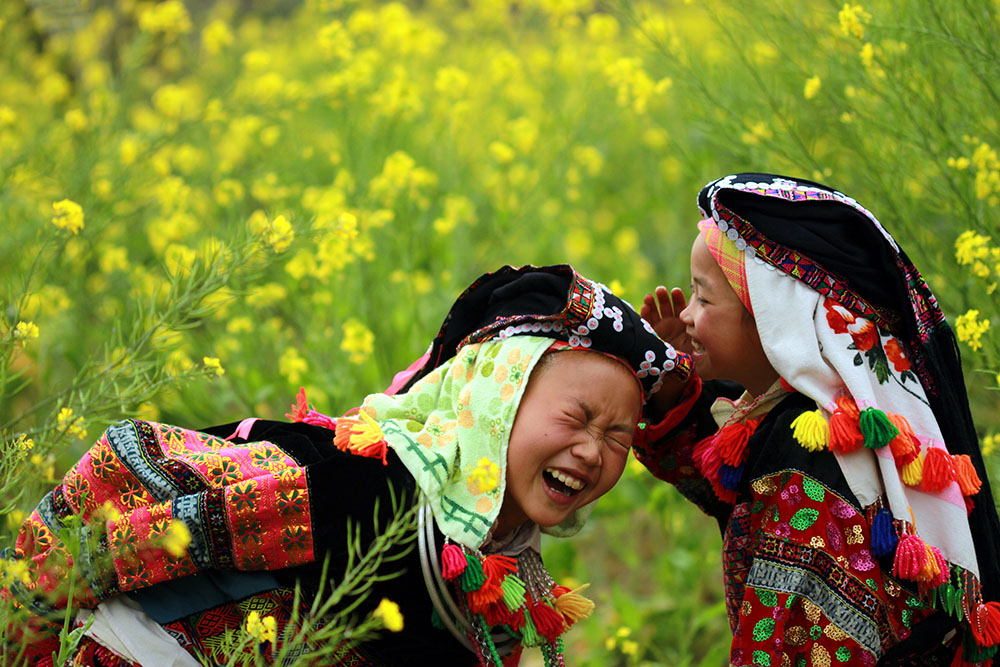
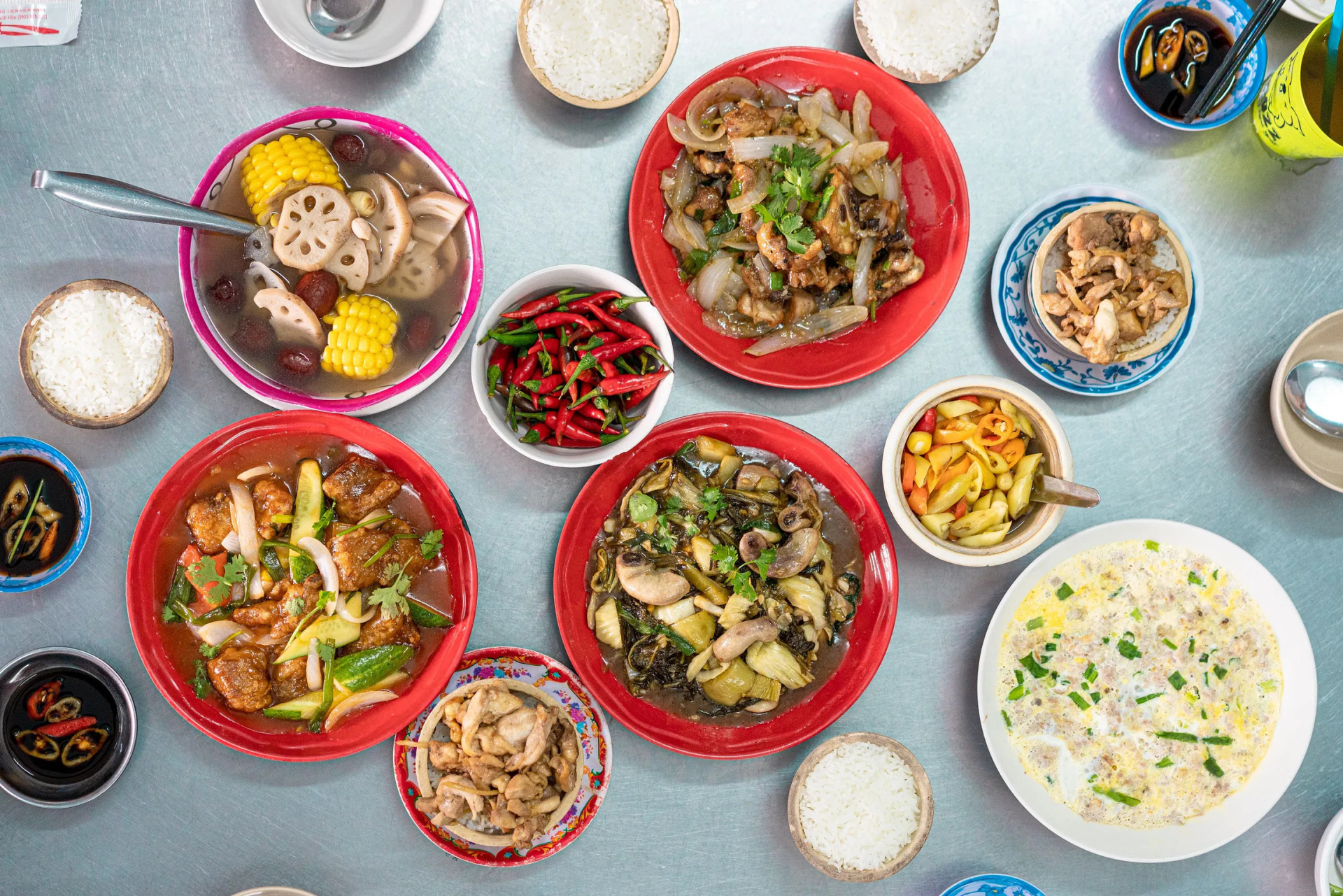
Tips for Traveling to Vietnam from Australia
-
Pack Appropriately
Vietnam's tropical climate means hot and humid weather year-round. Be sure to pack light, breathable clothing, and bring essentials like sunscreen, a hat, insect repellent, and comfortable walking shoes for exploring. -
Learn Basic Vietnamese Phrases
While many people in tourist areas can speak some English, learning a few basic Vietnamese phrases can go a long way in building rapport with locals and showing respect for the culture. Simple greetings and expressions of thanks are always appreciated. -
Be Cautious with Street Food
Vietnamese street food is a must-try, offering delicious and authentic local flavors. However, to reduce the risk of foodborne illness, choose busy stalls with a high turnover of fresh ingredients. It's also best to drink bottled or boiled water instead of tap water. -
Respect Local Customs and Traditions
Vietnam is a country rich in cultural heritage. When visiting temples or pagodas, always dress modestly and remove your shoes before entering. Be mindful of local customs and avoid discussing sensitive topics like politics or religion to respect local sensibilities. -
Transportation
Vietnam has an extensive and affordable transportation network, including buses, trains, and domestic flights. Choose the best options based on your itinerary and preferences. If renting a motorbike, ensure you have a valid license and always adhere to local traffic laws. -
Stay Vigilant and Safe
Like any travel destination, staying vigilant is important. Keep an eye on your belongings, particularly in crowded areas, and avoid walking alone at night in unfamiliar or poorly lit areas. Taking common-sense precautions will help you enjoy a safe and worry-free trip.

Maximizing Your Vietnam Trip: Tips for Every Traveler
Vietnam promises an unforgettable experience, whether you’re splurging like royalty or traveling on a tight budget. No matter your style, you’ll savor delicious food, explore vibrant cities, immerse yourself in rich cultures, and admire stunning landscapes in one of Asia's most captivating destinations. Check out our creative tips for making the most of your money while exploring Vietnam.
Daily cost:
|
Expense Category |
Budget Traveler |
Mid-range Traveler |
Luxury Traveler |
|
Accommodation |
$8 - $16 |
$16 - $40 |
$60 and up |
|
Food (Street Food) |
$4 - $8 |
$8 - $16 |
$16 and up |
|
Food (Restaurant Meals) |
$6 - $10 |
$12 - $20 |
$20 and up |
|
Transportation |
$2 - $6 |
$6 - $12 |
$12 and up |
|
Sightseeing & Activities |
$4 - $8 |
$8 - $20 |
$20 and up |
|
Miscellaneous |
$2 - $4 |
$4 - $8 |
$8 and up |
|
Total Daily Cost |
$20 - $35 |
$50 - $100 |
$120 and up |
Hanoi or Ho Chi Minh city airport?
Consider flying into Ho Chi Minh City (HCMC) instead of Hanoi. As the largest and busiest airport in Vietnam, HCMC offers more flight options, which often translates to cheaper fares compared to those heading to Hanoi in the north. However, keep in mind that HCMC is a more expensive city, so any savings from your flight could be offset if you stay for an extended period. Plan your itinerary with this in mind.
Traveling overnight
Traveling overnight is a great way to save both money and time in Vietnam. While budget flights can be cheap, they come with a higher carbon footprint. Opting for overnight transportation, like sleeper buses or trains, can be a more eco-friendly and cost-effective option. For longer journeys, such as from Hanoi or HCMC to Hoi An or Nha Trang, overnight travel allows you to skip the cost of one night’s accommodation and still make the most of your daylight hours for sightseeing. Both trains and buses offer reclining seats and horizontal berths for added comfort during the journey.
Eating street food
Eating street food is a must when in Vietnam. Street food is not just affordable but also an essential part of the culture. For a very reasonable price, you can enjoy a wide variety of dishes, from pho and banh mi to banh xeo pancakes and bun cha, as well as bold flavors like banana flower salad and bo la lot (beef skewers wrapped in betel leaves).
Throughout the day, especially at lunchtime and evening, street vendors set up plastic tables and chairs on the sidewalks, giving you a spot to sit while you savor your meal. Night markets and transport hubs are the best places to find a diverse range of tasty options.
Itinerary Flexibility
While planning your trip, leave room for spontaneity. Vietnam has so much to offer, from the bustling streets of HCMC to the tranquil landscapes of Ha Long Bay. Be ready to adjust based on weather, local festivals, or tips from fellow travelers.
Engage with Locals
Strike up conversations with locals to get a deeper understanding of Vietnamese culture and traditions. A little Vietnamese goes a long way, and locals are often happy to help visitors navigate their cities.
Stay Hydrated and Cautious with Food: Vietnam can be hot and humid, so drink plenty of water. If you’re sensitive to street food, start with simple dishes and gradually work your way up to more adventurous options.

Other Articles
YOU MAY ALSO LIKE

23 DAYS - Private Vietnam 23 Days 22 Nights - Major of VietNam Trip
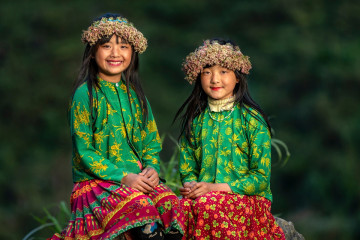
19 DAYS - Private Vietnam 19 Days 18 Nights - Explore Vietnam
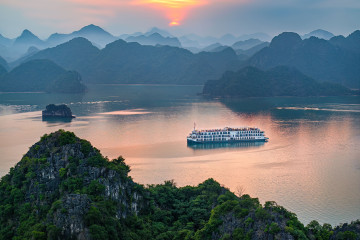
38 DAYS - Private Vietnam- Laos- Cambodia- Thailand 38 Days 37 Nights - Indochina Odyssey
Speak to Your Local Travel Expert





